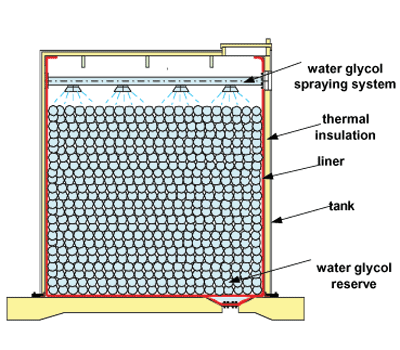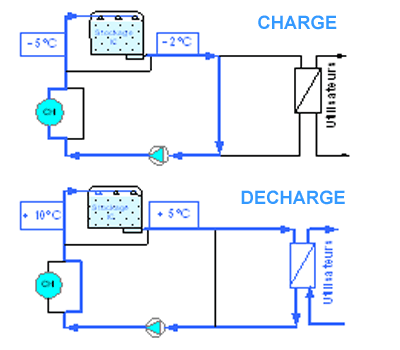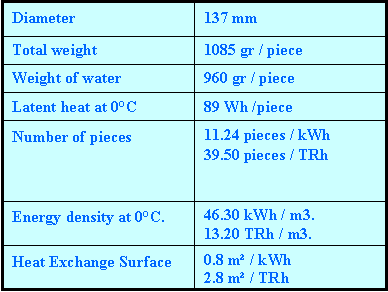Ice Spray system
What is the Ice spray system
How does it work
The “Ice Container”
The tanks
– steel tanks
– concrete tanks
Shipping, handling, storage, filling the tanks
Inside tanks and pulverization on the Ice Containers
What is the ICE SPRAY system ?
The Ice Spray system is an original Encapsulated Ice Storage System used to reduce peak capacity normally incurred by a building’s HVAC system without affecting comfort levels in the building.
Typically the Cooling Energy is stored at night, and used during the day in lieu or simultaneously with the chiller production.
The Ice Spray System is used in association with centralized chiller plants designed for large buildings or District Cooling networks.
The Ice Spray System is the most simple, reliable and cost effective system to store cooling energy in the HVAC field.
The Ice Spray System affects the following parameters:
– the designed chiller plant capacity which can be strongly reduced
– the electrical energy consumption which can be spread out over 24 hours or totally stopped during the peak period.
– the production reliability which is improved because two different energy sources are used.
How does it work ?
The Ice Spray system includes:
the Ice Capsule/Container (IC) itself
the tank to store them.
The ICs are spherical plastic containers filled up with treated water.
The ICs are poured in bulk and dry-stacked into large tanks made of steel or concrete.
A water-glycol coolant sprayed over ICs proceeds to heat exchanges.
For charging, the coolant, cooled by chillers to below 0°C (32°F),is sprayed over the ICs, flows by gravity in cascading around them, building the ice inside.
For discharging, the sprayed coolant warmed-up by users to over 0°C (32°F), melt the ice inside ICs.
The Ice Capsule / Container
The ICs are spherical containers made of high performance plastic polymer.
The walls of the ICs are covered with a number of semi-spherical raised features specially designed to disturb the water-glycol coolant as it flows around them.
The ICs are factory filled with specially treated water.
An absorption body is put inside the ICs to absorb the water expansion during freezing.
Ice Capsules characteristics

The tanks
General Description
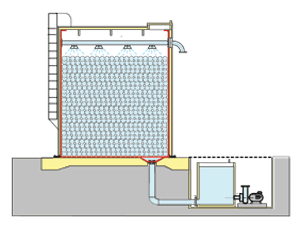
They are:
at the atmospheric pressure (not pressurized) made of steel or concrete construction cylindrical rectangular or any other shape but vertical in form with an identical cross-section over its entire height.
an upper header equipped with nozzles allows the coolant to be regularly sprayed over the Ice Containers.
the outlet of the coolant is located at the bottom of the tank.
a coolant reserve located in the tank’s bottom or below, allows to balance the coolant inertia around the ICs.
the water / glycol coolant pump is always located below the lower coolant level in the coolant reserve.
an air vent allows the tank to breath
installed above ground, below ground, indoors, outdoors or buried
Steel tanks
They are cylindrical and vertical. Prefabricated metal sheets of the tank are bend and bolted joint on site.
Tanks are totally assembled on site including:
– bolted steel sheets.
– insulation made of polyurethane panels.
– liner.
– upper header equipped with nozzles.
– an upper trap door for filling.
– a safety hoop ladder for access.

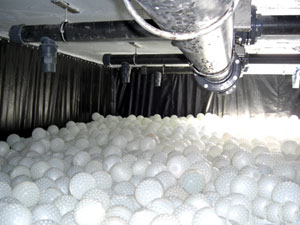
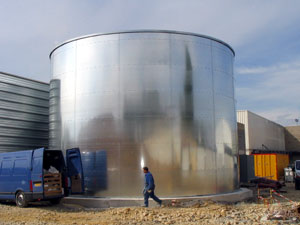
Road transportation of a 200 m3 tank – Upper part of a tank : spray pipes and nozzles above the ice containers – Cylindric steel tank
Concrete tanks
They are built above ground, below ground, indoors, outdoors or buried
For new facilities, the concrete walls of a basement can be used as part of the tank structure.
They are generally parallelepiped. Insulation is made of polyurethane (or similar) panels stuck on concrete walls.
Insulation is covered with a liner or a membrane.
If the coolant reserve is included into the concrete tank, no slope is required. The coolant reserve depends on the outlet piping position as the coolant level must always be over the outlet piping.
If the coolant reserve is not included into the concrete tank. The concrete tank has a slope > to 2% to allow the coolant to flow towards the outlet. The tank reserve has to be located below the tank’s bottom level.
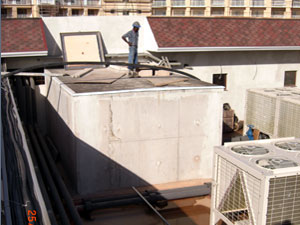
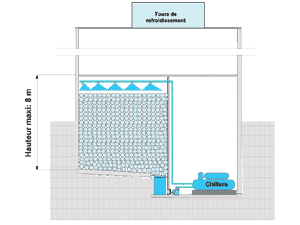
Semi-buried 100 m3 concrete tank – Underground tank sketch
Shipping – Handling – Storage – Filling the tank
Shipping
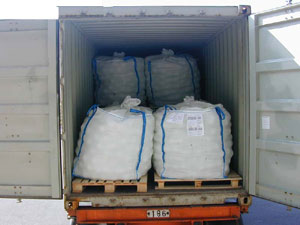
The ICs are packed and transported in “big bags” or in reinforced cardboards containing each 500 ICs. A 20′ sea container contains 9000 ICs, storing 2 big bags or 2 cardboards one above the other. A 40′ sea container contains 19000 ICs.
Handling
On site, a forklift truck is used for horizontal handling of big bags or of cardboards. For vertical handling, a crane equipped with slings is used to lift up the big bags or the cardboards.
Storage of Ice Capsules/Containers (ICs)
On site, the ICs are generally stored near the Ice Storage tanks, before filling. The big bags or cardboards must always be stored under cover, never under the sun and protected from dust, if possible in a closed building.

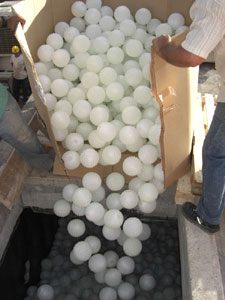
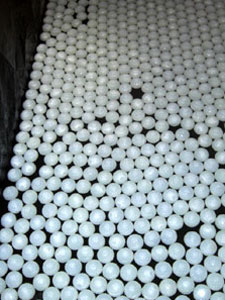
Bulk bags and cardboards in a sea container – Ice containers poured into a tank partially filled with water – The ICs spread themselves in the tank
Filling the Ice Storage tank
The Ice Storage tank must be first filled with water (without glycol). Then, the ICs are poured in bulk into the tank, through the filling trap. If ICs’ dropping height is above 2m, a plastic guide is used to drive the ICs. Once the ICs are filled into the tank, the water inside is drained and the water-glycol filled.
Tank ready for operations
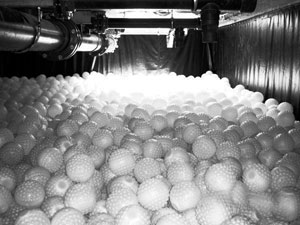

Tank filled with containers ready to operate – Spraying of glycol mixture over the ICs

